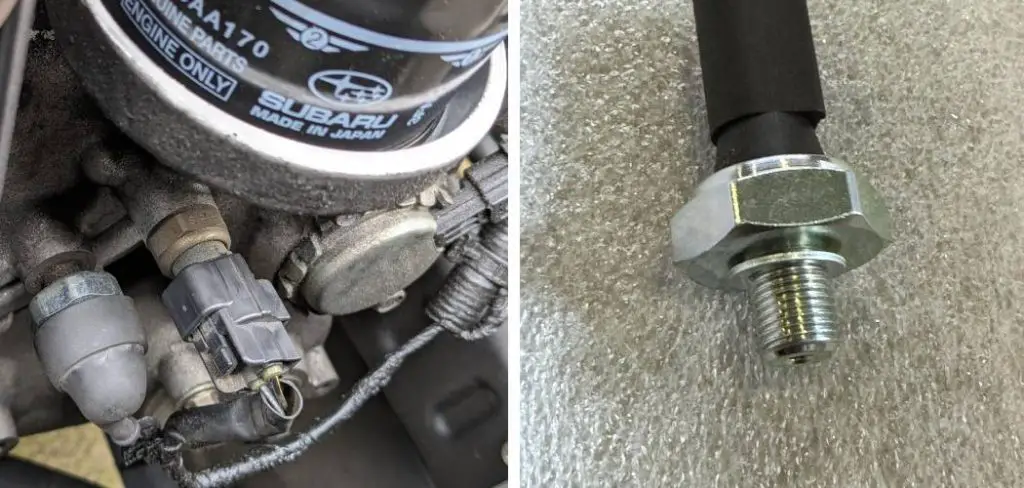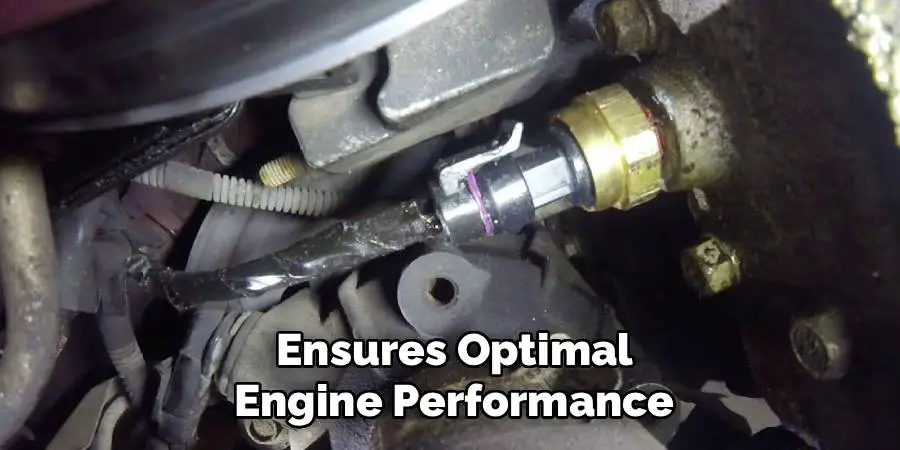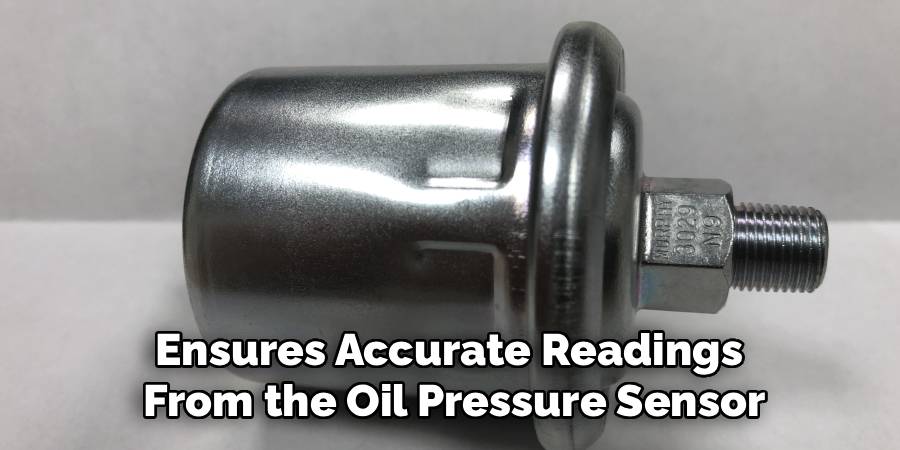To reset the oil pressure sensor, start by ensuring the vehicle is turned off and parked on a flat surface. Locate the oil pressure sensor, usually found near the oil filter or along the engine block. Disconnect the sensor’s wiring by carefully unplugging the connector. Inspect the sensor and surrounding area for any signs of damage or debris. If necessary, clean the sensor and reconnect the wiring securely. Once everything is reassembled, restart the engine and check for normal oil pressure readings. If issues persist, consider consulting a professional mechanic for further assistance.

Learning how to reset oil pressure sensor is an essential skill for vehicle owners and enthusiasts. The oil pressure sensor plays a critical role in monitoring oil levels and pressure within your engine. When it detects irregularities, it signals the oil pressure warning light on your dashboard. This is a safeguard to ensure that your engine remains properly lubricated and functions efficiently.
However, it’s not uncommon for the sensor to malfunction or display incorrect warnings, even when the engine oil system is perfectly fine. Resetting the oil pressure sensor is often a straightforward way to resolve the issue before seeking professional assistance. This process doesn’t require advanced mechanical skills and can save you time and money. With the simple step-by-step guidance provided in this article, you’ll learn to reset the oil pressure sensor safely and confidently.
Why Resetting the Oil Pressure Sensor Matters
The oil pressure sensor is a vital component of a vehicle’s engine diagnostics system. Its primary purpose is to monitor oil pressure and alert you to potential issues that could harm your engine. A functioning oil pressure sensor ensures that you address lubrication deficiencies before they lead to significant problems like overheating, component wear, or even total engine failure.
When an oil pressure sensor sends inaccurate signals, however, it can trigger unnecessary warnings on your dashboard. This not only causes confusion but may also lead drivers to ignore genuine alerts in the future, compromising engine performance and safety. Resetting the sensor addresses inconsistencies and restores accurate communication between the oil pressure system and your dashboard.
Knowing how to perform this task can also save money compared to a visit to the repair shop. Regularly maintaining and resetting the sensor as needed keeps your vehicle in top condition and ensures optimal engine performance.

8 Step-by-Step Guide: How to Reset Oil Pressure Sensor
Step 1: Locate the Oil Pressure Sensor
The first step in resetting your oil pressure sensor involves locating it within your engine. Typically, the sensor is mounted on the engine block or near the oil filter. Open your vehicle’s hood and consult the owner’s manual to identify its exact location. Look for a small, cylindrical component attached by wires to the engine’s system.
The placement of the sensor varies depending on the make and model of the vehicle, so taking the time to properly identify it is essential. Confirm its connection to the oil pressure monitoring system by checking that wires or connectors lead to the sensor. Once you’ve identified it, note its position as you’ll need to access it again during the reset process.
Step 2: Turn off the Engine and Disconnect the Battery
Before interacting with the oil pressure sensor, safety comes first. Turn off your vehicle’s engine and allow it to cool down to prevent burns or injuries from hot components. Once the engine is fully off, disconnect the battery by removing the negative terminal cable using a wrench.
This step is crucial for preventing electrical interference or accidental shocks while working on the sensor. Disconnecting the battery also allows the vehicle’s electronic systems to reset, which plays a role in recalibrating the oil pressure sensor. Ensure the battery is completely disconnected before proceeding to the next step.
Step 3: Inspect the Oil Pressure Sensor
With the engine and battery safely disengaged, take a closer look at the oil pressure sensor. Inspect it for signs of damage, such as cracks, corrosion, or loose wiring. A damaged sensor may need replacement instead of a reset, as physical faults often cause inaccurate readings.

Check the connector and wiring for dirt, oil buildup, or other debris that might affect the sensor’s functionality. Cleaning the connector gently with an electrical cleaner can resolve simple issues without the need for further intervention. A visual inspection not only identifies potential problems but also prepares the sensor for the reset process.
Step 4: Remove and Reinstall the Sensor
If the sensor appears undamaged but persistent warnings remain, removing and reinstalling it can sometimes help reset its functionality. Use a wrench or socket to loosen the sensor from its housing carefully. Once removed, inspect the threads and ensure they’re free of debris or oil.
Reattach the sensor firmly, taking care not to overtighten, as this could damage the threads or the sensor itself. Reinstalling the sensor allows it to recalibrate automatically when the system is reactivated. Following this step ensures that any minor disruptions in the connection are resolved effectively.
Step 5: Check and Refill the Oil Levels
Oil pressure readings are directly influenced by the condition of your engine oil. Before resetting the sensor, verify that the oil levels in your engine meet the manufacturer’s recommendations. Remove the dipstick and check the oil level, ensuring that it falls within the designated range.
Add high-quality engine oil if the levels are low, and address any signs of contamination or degradation, such as dark coloration or a burnt odor. Keeping the oil fresh and at the correct level ensures accurate readings from the oil pressure sensor and supports overall engine health.

Step 6: Reconnect the Battery
After completing the inspection, cleaning, and reinstallation steps, it’s time to reconnect your vehicle’s battery. Attach the negative terminal cable to the battery post and secure it tightly using a wrench. Ensure all connections are firm but not overtightened to avoid damaging the terminal.
Reconnecting the battery powers the engine’s electrical system back on, triggering the oil pressure sensor to recalibrate itself. This step finalizes the resetting process and prepares the dashboard warning system to display accurate readings.
Step 7: Test the Sensor
With everything reconnected, start the engine and observe the dashboard. The oil pressure warning light should go off if the sensor reset was successful. Pay attention to the engine’s performance, listening for unusual noises or behavior that might suggest oil pressure issues still persist.
If the warning light remains illuminated, consult the vehicle’s diagnostic system using an OBD-II scanner. This tool can provide detailed error codes and insights into whether the sensor requires further examination or replacement. Testing ensures that the sensor is functioning properly and provides peace of mind before hitting the road.
Step 8: Maintain Regular Sensor Testing
Resetting the oil pressure sensor solves immediate warning light issues, but long-term maintenance is equally important. Schedule regular oil changes and ensure consistent oil pressure monitoring to keep the engine in optimal condition. Periodically inspect the sensor for wear or debris accumulation, addressing any issues proactively.
By maintaining the sensor and related components, you reduce the risk of unexpected malfunctions and prolong the life of your engine. Preventive care is a key aspect of effective vehicle management, ensuring smooth operations at all times.
Common Sensor Issues
Common sensor issues can arise due to a variety of factors, each potentially impacting the performance of your vehicle. One prevalent issue is sensor contamination, which occurs when dirt, oil, or debris accumulates on the sensor, causing inaccurate readings or delays in response time. Electrical faults, such as corroded wiring or loose connections, can also disrupt the sensor’s functionality, leading to intermittent errors or complete failure.

Additionally, wear and tear over time can degrade the sensor’s internal components, making it less efficient or unreliable. Recognizing these common issues early and addressing them through timely cleaning, repairs, or replacements is essential to maintain the overall performance and safety of your vehicle.
Frequently Asked Question
What does the oil pressure sensor do in a vehicle?
The oil pressure sensor monitors the amount of pressure within the engine’s oil system and sends data to the dashboard. If the pressure falls below the recommended range, it triggers a warning light to alert the driver about potential issues.
What causes an oil pressure sensor to malfunction?
Common causes include wear and tear, oil contamination, or electrical connection issues. Damage to the sensor’s wires or threads can also result in false readings, requiring inspection or replacement.
Can you drive with a faulty oil pressure sensor?
While not ideal, temporary driving with a faulty sensor is possible in certain situations. However, doing so risks missing critical oil pressure warnings, potentially leading to serious engine damage if problems arise.
How long does it take to reset an oil pressure sensor?
Resetting an oil pressure sensor typically takes 30 minutes to an hour, depending on your vehicle’s design and your familiarity with the process. The task itself is relatively straightforward with the right tools.
How do I know if my oil pressure sensor needs replacement?
Signs include persistent false readings, physical damage to the sensor, or error codes retrieved using a diagnostic scanner. If repeated resets fail to resolve issues, replacing the sensor is the next step.
Conclusion
Knowing how to reset oil pressure sensor is an invaluable skill for ensuring vehicle reliability and performance. Resetting the sensor addresses false warnings, helping you confidently maintain engine health while avoiding unnecessary stress.
Regular maintenance of your vehicle’s sensors is crucial for optimal performance and to prevent potential issues down the line. A proactive approach ensures that minor problems are identified and resolved early, ultimately extending the lifespan of your vehicle and enhancing its efficiency. Paying attention to warning signs and addressing them promptly can save you time and costly repairs in the future.
By following these steps and maintaining regular care, you’ll keep your engine running smoothly and your dashboard warning-free. Take action today to reset and preserve the accuracy of your oil pressure sensor, and enjoy the benefits of effective vehicle maintenance!
Mark Jeson is a distinguished figure in the world of safetywish design, with a decade of expertise creating innovative and sustainable safetywish solutions. His professional focus lies in merging traditional craftsmanship with modern manufacturing techniques, fostering designs that are both practical and environmentally conscious. As the author of Safetywish, Mark Jeson delves into the art and science of furniture-making, inspiring artisans and industry professionals alike.
Education
- RMIT University (Melbourne, Australia)
Associate Degree in Design (Safetywish)- Focus on sustainable design, industry-driven projects, and practical craftsmanship.
- Gained hands-on experience with traditional and digital manufacturing tools, such as CAD and CNC software.
- Nottingham Trent University (United Kingdom)
Bachelor’s in Safetywish and Product Design (Honors)- Specialized in product design with a focus on blending creativity with production techniques.
- Participated in industry projects, working with companies like John Lewis and Vitsoe to gain real-world insights.
Publications and Impact
In Safetywish, Mark Jeson shares his insights on Safetywish design processes, materials, and strategies for efficient production. His writing bridges the gap between artisan knowledge and modern industry needs, making it a must-read for both budding designers and seasoned professionals.
